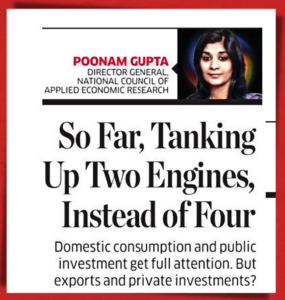Union Budget Supports Domestic Consumption as the Main Driver of Growth
02 Feb 2023
Opinion: Poonam Gupta

The 2023-24 Union Budget focuses on domestic consumption as the main engine of growth, followed by public investment as the second, albeit smaller, growth engine. Significantly, it has not equally supported private investment or exports as accelerators of economic growth or generators of employment.
The Government’s enthusiastic support to domestic demand is both reasonable and understandable, as domestic consumption has hitherto constituted nearly 55 percent of India’s GDP, recording an average growth rate of 7 percent during the last decade.
The critical fiscal support provided in the Budget to agriculture, the rural economy, and domestic tourism, coupled with lowering of the net income tax burden, will expectedly boost domestic demand.
One important shift observed in the Budget over the past three years, retained in the current Budget, is a phenomenal increase in the Union Government’s capital expenditure. It has increased from 1.7 percent of GDP in 2019-20 to 2.7 percent this year; and has been budgeted to increase further to 3.3 percent of GDP next year.
An increase in the government’s capital expenditure, if financed by diverting resources away from revenue expenditure, can help accelerate growth. If on the other hand, this increase is funded through an expansion of fiscal deficit, it is likely to foster competition with the private sector for private savings and in effect could crowd them out.
The proposal to increase capital expenditure, while leading to fiscal consolidation, would depend on a nearly flat revenue expenditure. Yet, it has proven hard to squeeze revenue expenditures in the past. For example, last year’s Budget had proposed to keep revenue expenditure almost flat, but it is now slated to increase by 8 percent in the Revised Estimates. Thus, two possibilities emerge. First, capital expenditure would be expanded by increasing the fiscal deficit, resulting in crowding out; or that they would fall short of the budgeted amount, and not provide the requisite impetus to growth.
In any case, public investment (by the Centre and States) is a small component of India’s GDP. It has averaged only 7 percent of GDP during the last decade. In comparison, private investment is three times as large. Private investments and exports together account for a full 40 percent of the GDP. The Budget has not provided a clear policy direction or support to these two key drivers of growth.
Let me cite a few examples.
Skilling is ultra-important for India to industrialise further and to move up the services sector’s value chain. Besides, the export of skills, particularly to the ageing advanced economies, can be a promising growth accelerator. The Budget has prioritised skilling through various targeted schemes. It is, however, not clear how the private sector would be leveraged in this endeavour, or for that matter in enhancing R&D or developing the tourism sector.
Another example is the absence of any follow-ups on the proposal in the 2021-22 Union Budget “to take up the privatisation of two Public Sector Banks and one General Insurance company in the year 2021-22.” The current Budget offers no roadmap for enhancing the private sector participation in crucial growth areas, including banking.
Another area that has been ostensibly ignored is promotion of an ecosystem for private equity and venture capitalists to operate in. The 2021-22 Budget had noted, “Venture capital and private equity invested more than Rs. 5.5 lakh crore last year, facilitating one of the largest start-up and growth ecosystems. Scaling up this investment requires a holistic examination of regulatory and other frictions. An expert committee will be set up to examine and suggest appropriate measures”. This year’s Budget does not provide any follow-ups for this proposal either.
Similarly, there have been no fresh attempts to attract Foreign Direct Investment (FDI) into the country in the Budget, over and above the existing sector-specific Production-linked Incentive (PLI) schemes. This is a notable gap, considering that FDI has been singularly important in making East Asia a manufacturing hub, as foreign investors bring with them, capital, technology, and access to global markets.
At a broad glance then, the Budget has accorded priority to agriculture and the rural economy over other sectors. It has placed greater emphasis on strengthening the domestic economy rather than leveraging the global economy. It has focused on spurring public investments rather than unleashing private investment.
Well, key policy announcements need not be confined to the annual budgetary exercise. Let’s hope that equally zealous announcements would follow through the year to support exports and private investments, both domestic and FDI. This would be crucial for ensuring that the Indian economy accelerates on all four engines, and not just on two.
Published in: The Economic Times, 02 Feb 2023







